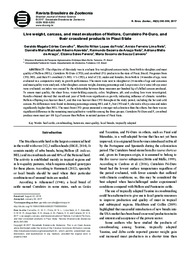Live weight, carcass, and meat evaluation of Nellore, Curraleiro Pé-Duro, and their crossbred products in Piauí State.
Live weight, carcass, and meat evaluation of Nellore, Curraleiro Pé-Duro, and their crossbred products in Piauí State.
Autoria: CARVALHO, G. M. C.; FROTA, M. N. L. da; LIMA NETO, A. F.; AZEVEDO, D. M. M. R.; ARAUJO NETO, R. B. de; ARAUJO, A. M. de; PEREIRA, E. S.; CARNEIRO, M. S. de S.
Resumo: The objective of this study was to evaluate live weight and carcass traits, from birth to slaughter, and meat quality of Nellore (NEL), Curraleiro Pé-Duro (CPD), and crossbred (F1) products in the state of Piauí, Brazil. Progenies from CPD, NEL, and their F1 crossbred (½ NEL + ½ CPD), a total of 252, males and females, from birth to 24 months of age, were evaluated in a comparative study in growth performance. The steers were sent to slaughter at 28 months of age and carcasses and meat quality were analyzed. After slaughter, carcass weight, dressing percentage and Longissimus dorsi area (rib eye area) were evaluated; an index was created by the relationship between these measures per hundred kg of chilled carcass produced. To assess meat quality, the shear force, water-holding capacity, color, brightness, pH, and cooking loss were investigated. Results obtained showed that month and year of birth were significant on growth, indicating influence of climatic variables. Nellore offspring was heavier than F1 and this was heavier than CPD throughout the study period, including the hot and cold carcass. No differences were found in dressing percentage among NEL and F1, but CPD and F1 showed a rib eye area and index significantly higher than NEL. The meat from CPD group presented a stronger red coloration than the others, but there was no significant difference in the remaining meat qualitative variables among the three groups. Curraleiro Pé-Duro and F1 crossbred produce more meat per 100 kg of carcass than Nellore in natural pasture of Piauí State.
Ano de publicação: 2017
Tipo de publicação: Artigo de periódico
Unidade: Embrapa Meio-Norte
Palavras-chave: Bovino de corte, Crossbreeding, Cruzamento, Heterose, Local breeds, Qualidade da carne, Raças locais, beef cattle, heterosis, meat quality
Observações
1 - Por padrão são exibidas publicações dos últimos 20 anos. Para encontrar publicações mais antigas, configure o filtro ano de publicação, colocando o ano a partir do qual você deseja encontrar publicações. O filtro está na coluna da esquerda na busca acima.
2 - Para ler algumas publicações da Embrapa (apenas as que estão em formato ePub), é necessário ter, no celular ou computador, um desses softwares gratuitos. Sistemas Android: Google Play Livros; IOS: iBooks; Windows e Linux: software Calibre.
Acesse outras publicações
Acesse a Base de Dados da Pesquisa Agropecuária (BDPA) para consultar o acervo completo das bibliotecas da Embrapa.

